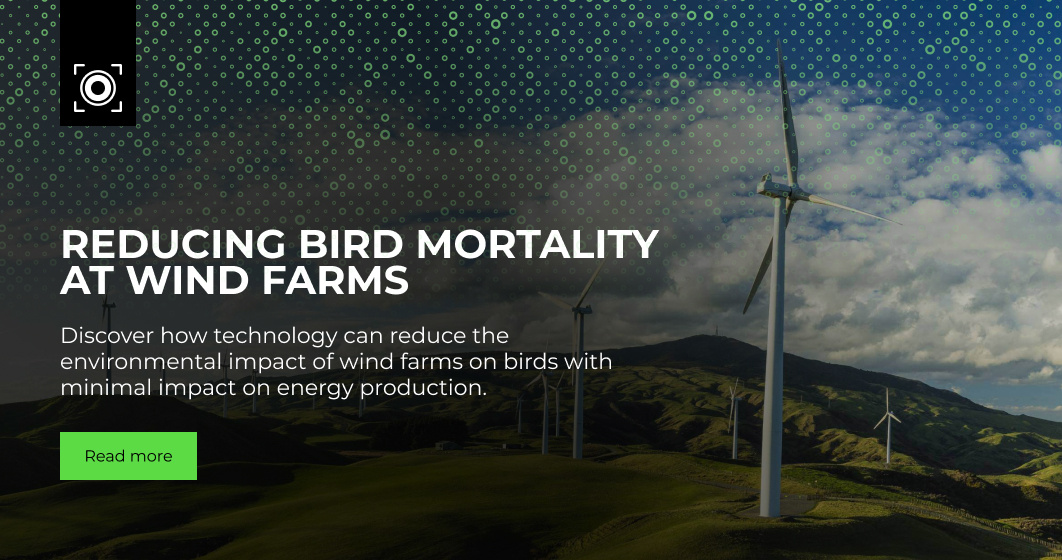Wind turbines are crucial to a sustainable future, generating renewable energy with each gust. But wind isn't the only thing that will cross their path. Airbourne animals, like birds and bats, regularly come into contact with wind farms, and site operators have long been concerned about the impact on bird and bat populations. But did you know that bird detection radar can help reduce wind farm bird and bat mortality?
Birds, Bats, and Wind Turbines
It's estimated that wind turbines cause over half a million bird deaths a year. Add to this the growth of the renewable energy sector, and it's easy to understand why environmentalists and site operators alike have accelerated their efforts to minimise wind farm bird mortality. With more wind farms built, the greater the chance of collisions.
These concerns extend to bats, too. While bat collision research is still evolving, people have reported collisions since the early 2000s, demonstrating a very real threat to bats. There's even evidence to support the theory that some types of bats are attracted to wind turbines, rather than being indifferent or actively avoided them.
How Are Birds and Bats Similar?
Birds and bats share similar characteristics. Both species fly at similar speeds, heights, and distances. Some sub-species also follow migratory patterns, making them more vulnerable to collisions at certain times of the year, especially when flying in unfamiliar places. Additionally, both types of animals nest and roost in trees.
Wind turbines impact both species through habitat loss, displacement, and causing mortality. They intrude their natural habitat, birds and bats might avoid the areas, and collisions are fatal.
Do You Need Different Radar Detection Solutions?
Due to their numerous similarities, you can use a single radar solution to detect both bats and birds.
An avian radar system can detect both birds and bats. It's designed to track flying objects automatically to mitigate the risk of harm.
Radar systems transmit electromagnetic energy toward objects and observe the echoes. The echo created by a bat does not differ much from that created by a bird, as both are similarly sized, flying at comparable altitudes and speeds.
The single-sensor system provides 24/7, real-time information about all birds and bats in the nearby environment, including location, distance, speed, and height.
Operators can see all this information at any time on a computer or mobile device, including computer and Android tablets, making it portable and easy to deploy. Additionally, the unique software can generate reports, like graphs detailing the frequency of sightings, so wind farm operators can monitor bird and bat activity over time.
How To Use a Bat and Avian Radar System At A Wind Farm
An avian radar system is useful to wind farm operators in three ways:
1. Pre-construction
When building a wind farm, operators must consider their environmental impact. There are lots of factors that can impact this, and we cover the key bird-related considerations for wind farms. Factors like existing bird and bat habitats, migratory patterns, and species diversity will determine your status in your mandatory environmental impact assessment (EIA).
A wind farm bird radar can monitor this key information for you. You can automatically detect and log birds and bats on your site, including their size, speed, direction, and flight path. This will help you gather data for your EIA in the pre-construction phase.
2. Monitoring Operations
Monitoring can continue when your wind farm is operational.
Bird detection radar use autonomous software that runs 24/7. This lets you track and monitor bird and bat activity while gathering data in real-time. The software stores this data so you can refer back to it at any time. This helps operational teams stay aware of activity, which can increase at certain times of the year due to migration. Research shows that a greater understanding of bird and bat activity helps operators reduce mortality, it even informed one operator to move their turbines to prevent future bird mortality.
3. Automatic Turbine Shutdown on Demand (SDoD)
Wind farm bird radar will continuously measure the presence of birds and bats on your site. When the number enters a specific threshold, set by you and your teams, the system automatically shuts down the wind turbines. You can do this with a group of turbines or even a single turbine. This allows operators to minimise downtime, for example, by ensuring the turbines remain off only as long as they need to prevent collisions.
This level of automation can become even more granular, too. You can change these settings based on:
- Time of day
- Bird behaviour
- Wind direction
- Wind strength
- Season
- Weather conditions
This is particularly useful if your wind farm experiences an overnight migration of bats, for example. And in the daytime, a flock of migrating birds.
Protect Bats, Birds, and Your Wind Farm
You want your wind farm operations to run smoothly. But you want to protect your reputation, too. An increasing number of wind farm operators now pay special attention to bird and bat mortality, so don't overlook this vital concern at yours. Discover how wind farm bird radar can help you quickly get started protecting your site, birds, and bats.


